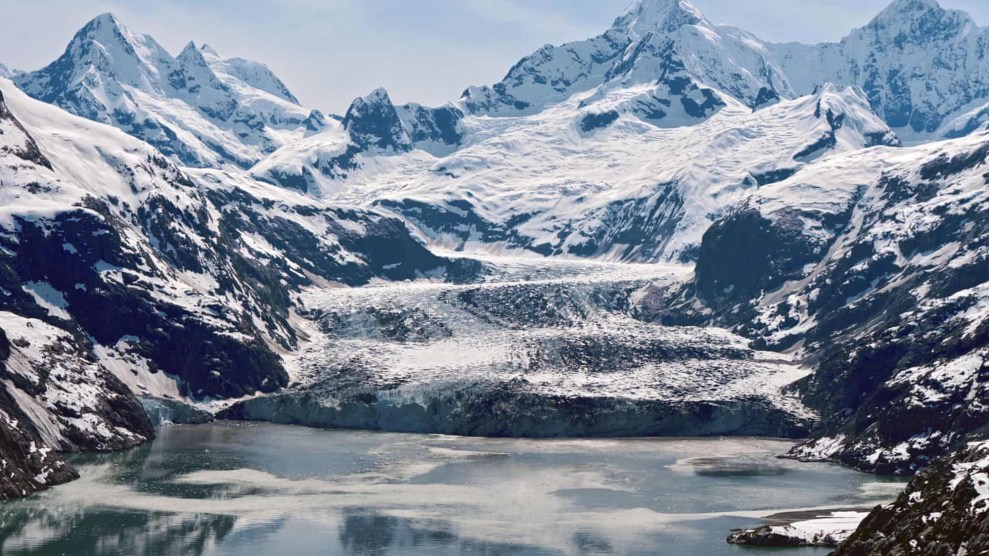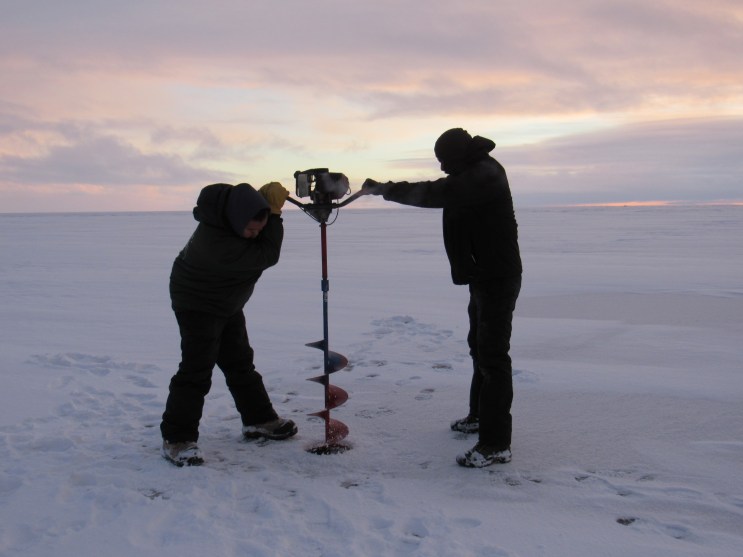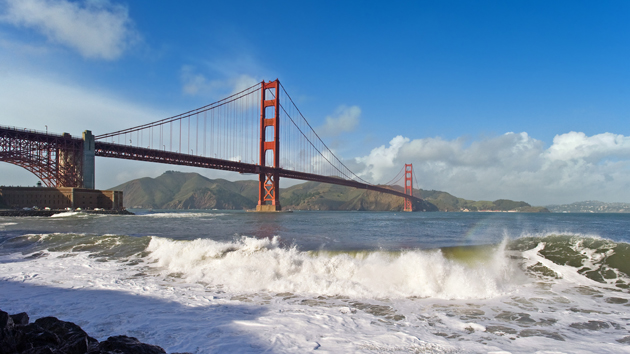
Johns Hopkins Glacier is one of more than 1,000 within the boundaries of Alaska's Glacier Bay national park.Nasa/Operation Icebridge/EPA
This story was originally published by the Guardian and is reproduced here as part of the Climate Desk collaboration.
If glaciers are what you are after, that’s the place for you.” The speaker was a prospector passing through Fort Wrangell, Alaska, in 1879. The subject was a remote bay, flanked by rugged walls of ice and filled with floating bergs. The listener was the Scottish-American environmental philosopher John Muir, who needed no further encouragement to set out in a canoe soon after with a large stock of provisions, blankets and a determination to visit the frozen wonderland.
It was October. Winter was approaching. The territory ahead was largely uncharted. His five traveling companions—four members of the Hoonah Tlingit people and a missionary—were warned the dangers were so great they would never return. Muir was undeterred. “The icy regions burned in my mind,” he noted. “I determined to go ahead as far north as possible.”
Over the following weeks, he travelled more than 800 miles, sketched and mapped what was later to be named Glacier Bay, and produced some of the most precise and rapturous prose about ice ever written in the English language.
Those records remain breathtakingly vivid today and serve as a historical baseline to assess how much the landscape has been reshaped in the subsequent 142 years, most recently by manmade climate disruption.
Nowhere in the world is losing glacier ice as rapidly as Alaska. This single region accounts for about a quarter of global mass loss, more than twice the share of other areas including the Greenland periphery and the Himalayas. That is a global concern because glacier loss is a bigger source of sea level rise than the polar ice sheets.
Headlines on this subject tend to focus on quantifiable impacts—kilometers of retreating glacier, gigatons of melting ice, millimeters of sea level rise—but Muir’s notes from the 19th century are a reminder the loss goes immeasurably deeper.
“Wherever there were glaciers, the world was in a constant state of creation,” he wrote after reaching the bay, studying the wildlife, botany, geology, and observing the constant calving of bergs from the main walls of the glacier.
The adjective “glacial” may have become a synonym for slow, but the processes behind ice river formation are extraordinarily dynamic and important. They are a vital component of the Earth’s life-support system. In the mountains, the seasonal pulse—freezing expansions in the winter and melting shrinkage in the summer—regulates temperature and water supplies. Without it, hundreds of millions of people living downstream in deltas along the Indus, Santa and Rhone would be more prone to droughts, while hydropower stations and salmon populations along the Columbia, Fraser and Alsek would suffer shortfalls.
Tidal glacial systems, like those Muir visited, also function as a climatic financial system accumulating, saving and redistributing precipitation over decades and centuries. Each deposit is an advance down the valley. Each withdrawal a retreat. As they move forward, they smooth, carve and carry rock. When they withdraw, they leave behind new habitats for trees, moss and mammals. There is no more powerful broker between geology, climate and biology.
Muir believed the glaciers were also a fountain of culture. “The great poets, philosophers, prophets, able men whose thoughts and deeds have moved the world, have come down from the mountains,” he wrote. He knew glaciers inspired worship among mountain communities from Tibet to the Andes, as well as ecstatic prose by romantic poets and polar explorers alike.
The Dunbar, East Lothian-born naturalist felt so close to the divine in the presence of ice that he was too excited to sleep: “The starlight was so full that I distinctly saw not only the bay with its multitude of glittering bergs, but most of the lower portions of the glaciers, lying pale and spirit-like amid the huge silent mountains. The nearest glacier in particular was so distinct that it seemed to be glowing with light that came from within itself. Not even in dark nights have I ever found any difficulty in seeing large glaciers; but on this mountain top, amid so much ice, in the heart of so clear and frosty a night, everything was luminous, and I seemed to be poised in a vast hollow between two skies of equal brightness.”
The interplay of light and ice have been a source of delight for countless tourists in the years since, but few have conveyed this with the skill of Muir. On another evening, he stands transfixed at a sunset that spreads crimson light across the Fairweather mountains and then down to the ice-filled bay.
“When the highest peak began to burn, it did not seem to be steeped in sunshine, however glorious, but rather as if it had been thrust into the body of the sun itself. Then the supernatural fire slowly descending, with a sharp line of demarkation (sic) separating it from the cold, shaded region beneath, peak after peak, with their spires and ridges and cascading glaciers, caught the heavenly glow,” he writes. “How long we gazed I never knew. The glorious vision passed away in a gradual, fading change through a 1,000 tones of color to pale yellow and white, and then the work of the ice-world went on again in everyday beauty.
“The green waters of the fiord were filled with sun-spangles; with the upspringing breeze the fleet of icebergs set forth on their voyages; and on the innumerable mirrors and prisms of these bergs, and on those of the shattered crystal walls of the glaciers, common white light and rainbow light began to glow, while the mountains, changing to stone, put on their frosty jewelery, and loomed again in the thin azure in serene terrestrial majesty.”
The ice rivers ran down into the ocean, making them tidewater glaciers, which wax and wane over centuries, each at a different pace. In Taylor valley, Muir saw the young Brady glacier growing. In Glacier Bay, he described an older one breaking apart.
More than a century earlier—in the depths of the little ice age—the native population of Hoonah Tlingit people had been forced to abandon their homeland on the shore when the main Grand Pacific Glacier advanced so rapidly that it filled the entire fjord. By Muir’s time, giant walls of ice still jutted far out into the water but the retreat was under way.
Though he did not know it, the natural cycle of glaciers had a new competitor. The late 18th century was also the dawn of the Industrial Revolution, which was to become a steadily greater disruptive influence. First factories, then steam trains, then cars and air conditioners pumped ever more carbon, methane and other greenhouse gases into the atmosphere, driving up temperatures and accelerating ice loss. The trend has been amplified by the loss of reflective white surfaces, leaving the Earth’s polar regions and high mountains heating twice as fast as the global average.
In Alaska, this has been documented in precise detail. Since Muir, the scientific baton has been handed down through generations of Glacier Bay specialists—William Cooper, Edward LaChapelle, Austin Post, Mauri Pelto and Christopher McNeil.
Pelto, a professor of environmental science at Nichols College in Massachusetts and the director of the North Cascades Glacier Climate Project, first visited the area in the summer of 1982, when he landed in the fjord on a float plane as part of a Nasa-backed expedition. Even then, he recalled, the landscape was very different from Muir’s day. “I was standing where the glacier wall would have been, but it was nowhere to be seen. I turned around and said to my colleagues, ‘I don’t even know which direction to go to hike to the glacier.’”
The team needed three hours of bushwhacking to reach it. In the decades since he has returned multiple times, and has worked on glaciers every summer, camping on them for more than 800 nights. Since 1998, the ice has retreated rapidly and the forest of alders and hemlock has grown more dense. No longer does a glacier reach the Muir Inlet. “If John Muir went to some of the same places today, he wouldn’t even see a glacier. What would be write about? Open water and a young growth forest?”
If this was just one bay, it would be no cause for concern. Glaciers have always gained in one valley and lost in another. The difference today, he said, is that all the glaciers in the region are declining at the same time.
It is as though the pulsating lights on a Christmas tree were steadily dimming and starting to flicker out in tandem. In this corner of Alaska, the brightest and biggest until very recently was Taku, the primary outlet glacier of the Juneau Icefield which neighbors Glacier Bay. When Muir visited, this was an advancing body of ice on its way to becoming one of the mightiest mountain glaciers in the world. It later reached a thickness of 1,480 meters, greater than the height of Ben Nevis.
By 1962, Taku was such an impressive symbol of the power of nature that the Humble Oil company spread its photograph across a double-page advertisement in Life Magazine with the boastful caption: “A river of ice stretching 270 square miles yet the petroleum energy Humble supplies could melt it at the rate of 7 million tons a day.”
Today, that ad reads as both hubristic and prescient. Humble was later rebranded as ExxonMobil, which has become one of the biggest greenhouse gas polluters on the planet while Taku was to suffer the consequences. After advancing throughout the 20th century, this vast glacier seemed immune to climate change. But around 2013, it paused, and then began to reverse in 2018 during a record heatwave in Alaska. For Peito, who had personally worked on 250 glaciers, the fall of the last hold-out against global warming was a sobering moment. “That makes the score climate change 250, alpine glaciers 0,” he wrote in a blogpost announcing the news.
The uniformity of the pattern alarms him. “They are not normally synchronized. But now, it doesn’t matter where glaciers are in the cycle, they are all in retreat. Climate change dominates far more than it did in the past. At no point in the 20th century did we see such a ubiquitous retreat of glaciers.”
He compares the situation to a devastating financial collapse. “In a pandemic or recession, lots of companies have trouble but some thrive. Normally, it is the same with glaciers. Even when there is a climate fluctuation, some do well. But what is happening now is on a scale that is far more catastrophic than a recession or pandemic. There is just no escape. There is no secret. Even having a high mean elevation cannot protect glaciers.”
To varying degrees, the story is the same across the world. Recent satellite observations have found rapid glacial thinning across every high altitude and high latitude region with the exception of the north-east Atlantic. Worst affected are low altitude mountains such as the European Alps, where 80-90% of the ice is expected to disappear by mid century.
In Africa, the first glaciers to disappear were reported last year: The Rwenzori Mountains—which are a source of the Nile—have no glaciers for the first time in at least 10,000 years. Ice on the continent’s loftiest peak, Kilimanjaro, is expected to follow soon. Asia, which is home to a cluster of the highest ranges in the world—Himalayas, Kunlun, Karakoram, Altai, Pamir, Tien Shan and Hindu Kush—had been relatively resistant, but this “Karakoram anomaly” now appears to be over. Even Everest is not immune.
More recently, the burning of the Amazon rainforest discharged a cloud of soot that accelerated the melting of 5,000 meter-high glaciers in the Bolivian Andes. Even the remote Antarctic is not immune. In January 2020, scientists at a polar research base detected black carbon that had floated across the Pacific from the record bushfires in Australia. This, however, pales into insignificance compared to the impact of warming air and oceans, which is eroding giant southern glaciers, such as Thwaites.
If Thwaites and other Antarctic glaciers break into the ocean, sea levels would rise rapidly. Similar long-term fears focus on Greenland’s glaciers and ice sheet. But today, the melting of mountain glaciers is the bigger problem, contributing more than a quarter of the extra volume being added to the world’s oceans. Much of it comes from Alaska, where glaciers are thinning by a meter every year—double the world average.
The risks are not just to coastlines, but in the possibility that ancient cycles of creation may have been broken, that harbor seals and other wildlife may have permanently lost their nurseries, that a rich source of joy and inspiration may be drying up. For Peito, the picture is dismal: “We keep updating the data, and the story keeps getting worse. The big, high-altitude glaciers will be around for a while yet, but many low-altitude glaciers will disappear by the time my grandchildren grow up. That’s hard to take.”
For city residents who have never seen a glacier up close, that may seem a remote concern, but distance can be misleading as Muir observed in perhaps his most famous line: “When we try to pick out anything by itself, we find it hitched to everything else in the Universe.”













